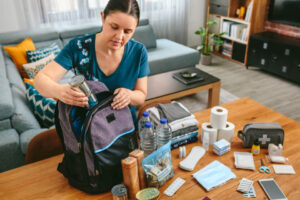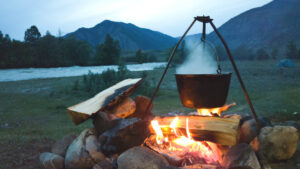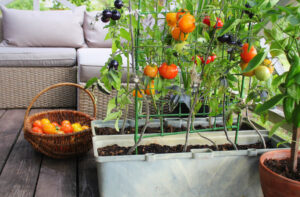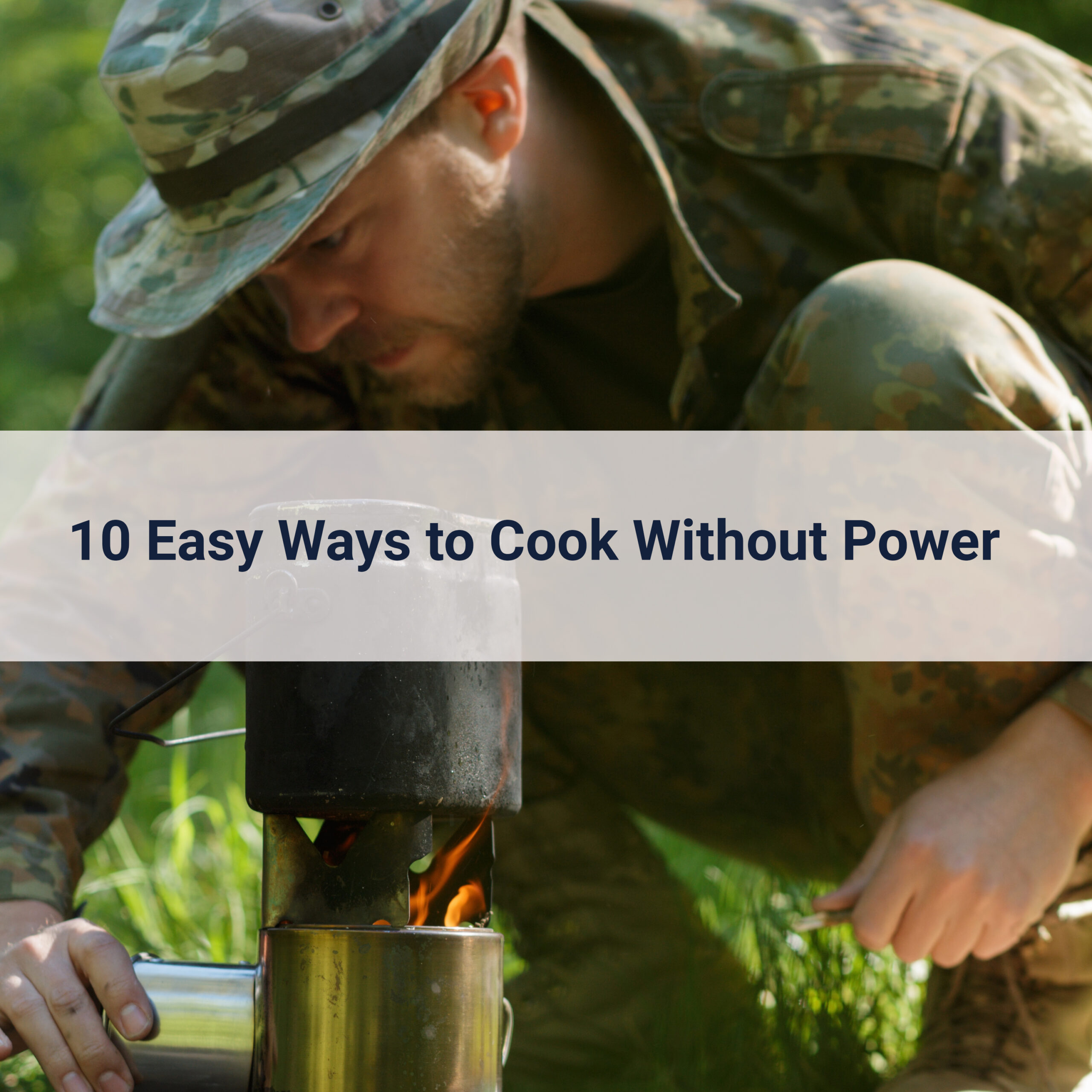
If you’re preparing for an uncertain future, you probably have a plan. But is knowing how to cook emergency food without power part of that plan? This is must-have knowledge because it’s unlikely the electrical grid will function properly following a significant disaster.
Because we are all so accustomed to our modern-day electronic devices and appliances, many of us don’t have the slightest clue what we’d do without electricity for a week, let alone a month or more. It’s sad when you think about it. Our ancestors spent their entire lives without electricity and managed to survive just fine. If we could suddenly bring them back during a lengthy power outage, they’d have a much easier time adapting than most of us would. Unfortunately, they’re not returning. But our appetites will come back very quickly following a blackout.
You and your family members will need to eat, and you’ll want some food that requires heating. Especially if the grid is down for a week or more. Granola bars taste great, but you’ll get tired of them after a while. Fortunately, there are numerous ways to prepare food without electricity. In this article, we’re going to give you the top 10 easiest, most conventional methods for cooking food without power. It’s essential that you prepare & learn how to do this now so you’ll be ready when the time comes.
10 Easy Ways to Cook Survival Food When the Power Goes Out
1. Solar Oven Cooking
This is a great option in warmer, sunnier climates. This outdoor emergency cooking method works by converting sunlight to heat. The trapped heat is used to cook food.
Solar ovens range from DIY ovens made out of a tire tube with a piece of Plexiglas over the top, to heavy-duty commercial ovens for purchase. You can bake, boil, steam, stew and dehydrate food – giving you the ability to cook just about anything. This is a safe option without flames and is 100 percent sustainable because no fossil fuels are required and no air pollution is produced.
This method is very portable and incredibly low maintenance, as food almost never sticks or burns. Most meals don’t require much stirring during cooking. No special kitchen equipment is required with this emergency food prep strategy. Just be sure to have a covered baking dish, mixing bowl and spoon.
If you’re new to solar oven cooking, choose recipes that do well with slow cooking such as stews and casseroles. This emergency cooking approach won’t include the browning that takes place in a conventional oven, but a simple sprinkling of herbs on the top of dishes will provide an extra visual appeal.
This will require a bit of patience, so try to wait until you’re certain the meal is done before checking. Each time you open the oven, heat will escape and you’ll need to add an additional 10 to 15 minutes of cooking time to regain that higher temperature.2. Portable Gas Stoves
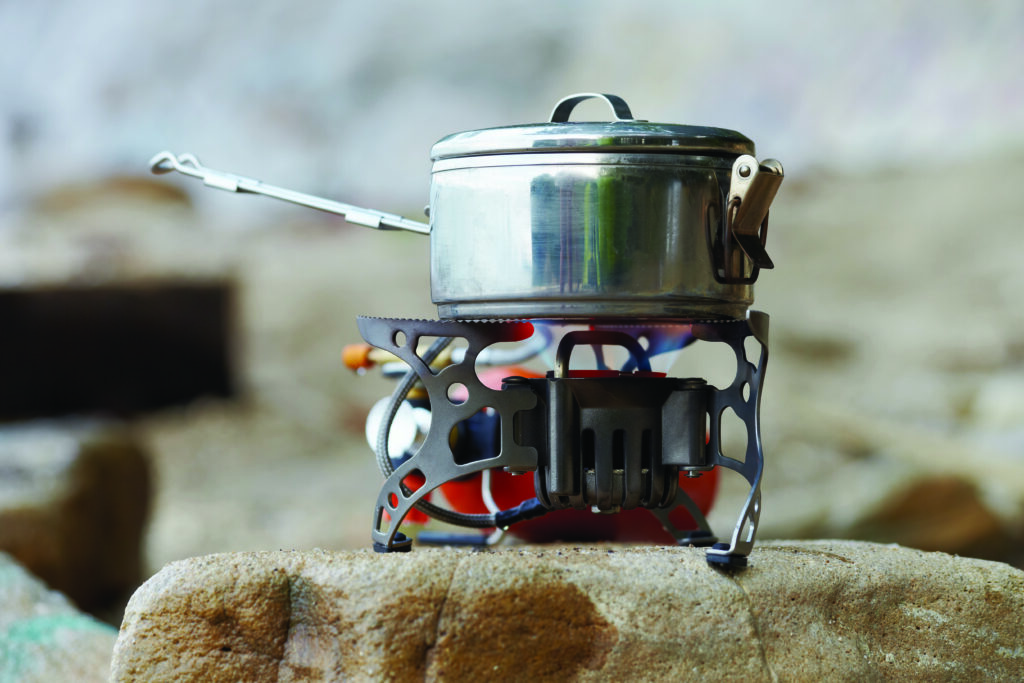
These are best used as an outdoor emergency cooking method. There are ways to maintain safely indoors (open windows, carbon monoxide detectors, etc.), but it’s always better to stay on the safe side and keep this cooking technique outside. The two best options in this category are powered by propane and butane.
Butane stoves are very portable and can generate enough heat to do most cooking. However, the butane canisters can be pricey and hold a limited amount of fuel. This arrangement is best for short-term emergency cooking. Butane does burn cleaner, so it’s a little safer to use indoors, but we still recommend outdoor cooking with this method if at all possible.
Propane is a highly dependable fuel at freezing temperatures and high altitudes. The tanks, however, are thick-walled and therefore too heavy to easily carry. This tactic is best for home emergency cooking during disasters that don’t involve evacuation.
The smaller stoves in this genre, some of which are also known as camper stoves, are single burner stoves, but you can also acquire a two-burner stove. Either way, make sure you know in advance which particular fuel it uses. If portability is not an issue for you, larger camper stoves with legs are very effective.3. Wood & Coal-Burning Stoves
These wood-burning and coal-burning stoves are especially convenient for use in the winter when you can cook and heat your home simultaneously. If it is flat enough, you can cook right on top of it. Again, using the proper type of fuel is important.
The fire should be going strong before you start cooking. It’s best to use cast-iron cookware because it conducts heat but does not retain it. Frying time might be close to what you’d experience using a conventional gas or electric stove, but cooking time will be longer, so plan accordingly.
If it seems like your food is cooking too quickly, turn down the drafts and transfer the food to a cooler part of the stovetop. If it’s cooking too slowly, open the drafts and add wood to the fire.4. Barbecue Grills
Using gas or charcoal, barbeque grills are associated more closely with good times than with bad. But if you’re able to hunker down at home to ride out an emergency – or you have one of these grills at your bug-out location – it will come in handy for cooking without electricity.
This is a great way to grill various meats and fish, as well as large vegetables. Grills have a big advantage over open fire cooking because of their lids. This traps more heat inside. And that means your meat will cook more evenly and more quickly.5. Open-Fire Cooking

This is a simple outdoor solution for cooking during a disaster. Find 3 sturdy, tall branches to create a structure to suspend a pot from above your fire. Two of the branches should have a Y-shaped end so that you can balance the third branch on them like you see in the picture above.
An even easier way to cook over an open fire is to set a barbecue grill plate over it and cook. If you don’t have a grill, you’ll need to find branches (ideally two inches thick) and carefully secure three of them over the fire.
Set your pan or pot on top of the branches and watch very closely. The branches will burn away. As they do, you’ll need to carefully slip in replacement branches. Plan ahead with how many branches you’ll need, based on required cook time. This isn’t an easy method and should be practiced often in non-disaster circumstances.
A third option with this open-fire cooking approach is using a large, flat rock. Place the rock over the fire. Once the rock is hot, put your pan or pot on top. The harder the rock, the less likely it is to crack at high temperatures.
If possible, use granite, marble or slate rocks, and make sure they are dry. Adding a few flat rocks to your landscaping is a great way to beautify your yard while simultaneously preparing for an emergency.6. Fireplace
Another option if you’re able to hunker down rather than bug out is a fireplace. Obviously you want to keep your flue open, and make sure you never use charcoal because carbon monoxide will be the result. Logs, on the other hand, will work well, and newspaper pages can assist.
The type of wood you use is also important. Well-seasoned hardwoods including oak, hickory, maple and ash will be particularly effective. Unseasoned wood, which contains much more moisture, will not burn nearly as well.
Just wrap your food in foil and cook it over the flame. Before you starting cooking, though, make sure there are plenty of glowing embers at the bottom of the fire. If you start cooking before the fire is going strong, you may be tricked into thinking your food is cooked well enough before it really is.
Before you wrap meat in aluminum foil, add some vegetable oil, as well as a little salt and pepper. Use tongs, rotate the food often and use a meat thermometer to make sure the inside of the meat is 165 degrees Fahrenheit before removing it from the fire. Use grates on which to place your skillets, and perhaps a hanging cauldron for soups, stews, etc.7. Fondue Pot
If nothing else, maybe you can use a fondue pot to cook a small meal. Obviously the fuel being used should be approved for indoor use.
Stainless steel is the way to go here, both for cooking and for cleaning up afterwards. Make sure the handles are strong and that the base is wide enough to be stable in a variety of circumstances. Most burners are fueled with denatured alcohol or fondue fuel gel.8. Engine Cooking
This outdoor emergency cooking method uses excess heat from your car or truck engine. It’s a last-resort cooking tactic because most preppers have multiple emergency cooking plans in place. If you have enough gasoline, engine cooking will feed you in a crisis and is relatively simple.
Identify a hotspot such as the exhaust manifold. Wrap your prepared food in several layers of tin foil, which will act as a heat conductor and protect your food from possible contaminants present in the engine compartment.
Secure the food with a steel wire and make sure it’s not touching any moving parts. Close the hood and let your food cook. Check the temperature of your food with a thermometer before you eat it.9. Canned Heat Cooking
This is a safe, inexpensive and easy indoor emergency cooking procedure. You’ve probably seen this flaming canister used by caterers to keep food warm at events. The no-spill, gel-like fuel is simple to use and can burn for several hours.
The canisters are safe to store indoors, take up little space and have a long storage life. Make sure to always store them upright and away from heat sources. Canned heat can be used with a chafing dish, fondue pot or certain stoves and grills. When cooking, make sure the heat is under the center of your pan or dish. Be sure to cover with a lid to help achieve a higher temperature and conserve fuel.
Please use caution, as the flame may be difficult to see, depending on lighting. When you’re finished cooking, don’t blow on the flame to extinguish it. Always smother the flame with the snuffer and be sure to let the can cool before replacing the lid.10. Meals That Heat Themselves/Portable Cooking Bags
One of the simplest methods of emergency cooking is food that has built-in heating elements within the packaging. Many MREs (also referred to as self-heating food packaging) include this option in their packaging and have the ability to heat food contents without external heat sources or power.
A similar variation is a portable cooking bag, which is often used for camping. This strategy allows you to heat food in a chemically heated pouch.
All these methods for cooking without electricity are great. But what if you just need a cup of coffee, tea or hot chocolate? Or you need to cook something in the wild undetected? That’s why we recommend this personal solar cooker.
You can boil water in minutes — without fuel or flame, using just the sun. Not only is it great for hot drinks but also purifying contaminated water, cleaning up dirty dishes, or cooking a quick meal like oatmeal or hot dogs. Hot water can make all the difference when you’re roughing it. We also love this extra large solar cooker if you’re looking to boil water for more than one drink at a time.
